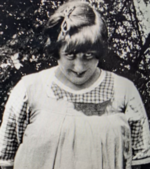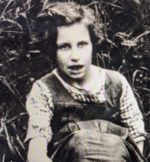
Summary
Nerissa Jane Irene Bowes-Lyon (18 February 1919 – 22 January 1986) and Katherine Juliet Bowes-Lyon (4 July 1926 – 23 February 2014)[1] were two of the daughters of John Herbert Bowes-Lyon and his wife Fenella (née Hepburn-Stuart-Forbes-Trefusis). John was the brother of Queen Elizabeth the Queen Mother, thus his two daughters were the maternal first cousins of Queen Elizabeth II and Princess Margaret, sharing one pair of grandparents, Claude Bowes-Lyon, 14th Earl of Strathmore and Kinghorne, and Cecilia Bowes-Lyon, Countess of Strathmore and Kinghorne.[2]
Nerissa Bowes-Lyon | |
|---|---|
 | |
| Born | Nerissa Jane Irene Bowes-Lyon 18 February 1919 England |
| Died | 22 January 1986 (aged 66) Royal Earlswood Hospital, Redhill, England |
Katherine Bowes-Lyon | |
|---|---|
 | |
| Born | Katherine Juliet Bowes-Lyon 4 July 1926 England |
| Died | 23 February 2014 (aged 87) Surrey, England |

Background edit
Nerissa Bowes-Lyon was born on 18 February 1919 and Katherine Bowes-Lyon was born on 4 July 1926, the daughters of John Herbert Bowes-Lyon and Fenella Hepburn-Stuart-Forbes-Trefusis. Their father, the second son of Claude Bowes-Lyon, 14th Earl of Strathmore and Kinghorne, was a brother of Lady Elizabeth Bowes-Lyon, the future Queen Elizabeth II's mother. Their mother was the younger daughter of Charles Hepburn-Stuart-Forbes-Trefusis, 21st Baron Clinton.
The 1963 edition of Burke's Peerage listed Nerissa and Katherine as having died in 1940 and 1961 respectively;[1][3] but in 1987 it was revealed by The Sun that the sisters were alive, and had been placed in Earlswood Hospital for mentally disabled people in 1941. In the terminology of the era, both were classified as "imbeciles", and neither learned to talk.[4] Nerissa died in 1986, aged 66, with only hospital staff attending the funeral,[4] while Katherine died in 2014, aged 87.[5] The sisters received no money from the family other than £125 paid to Earlswood each year.[4] Earlswood closed in 1997.
Controversy edit
Suggestions of a cover-up were rejected in the press by Lord Clinton in 1987, who claimed that his aunt Fenella (the mother of the two women) had completed the form for Burke's incorrectly due to Fenella being "a vague person"; however, Burke's included specific dates of death for both sisters.[6] According to a 2011 television documentary about the sisters, The Queen's Hidden Cousins, broadcast by Channel 4, "throughout their time at the hospital, there is no known record that the sisters were ever visited by any member of the Bowes-Lyon or royal families, despite their aunt, the Queen Mother, being a Patron of Mencap" (a charity for people with learning disabilities). Nurses interviewed on the documentary said that, to their knowledge, the family never sent the sisters a birthday or Christmas gift or card. When Nerissa died in 1986, none of her family attended the funeral. She was buried at the nearby Redstone Cemetery, Earlswood.[7] Her grave was marked with plastic tags and a serial number until her existence was revealed in the media, after which the family added a gravestone.[1][6][8]
Sources from within the family, however, report that their mother Fenella often visited the two sisters until her death in 1966; Lady Elizabeth Shakerley, Fenella's granddaughter, also said other members of the family had often visited over the years and had often sent gifts and cards on Christmas and birthdays. Queen Elizabeth The Queen Mother, upon discovering that her nieces were alive in 1982, sent money for toys and sweets on their birthdays and at Christmas.[9][10] Other than statements from within the family, there is no evidence for these visitations occurring.
The three grandchildren of Fenella and John (Lady Elizabeth Shakerley, the 5th Earl of Lichfield, and Katherine Somervell) organised the headstone for Nerissa Bowes-Lyon.[citation needed]
Other family members edit
Three mentally disabled cousins of the girls also lived in Earlswood Hospital. Harriet Hepburn-Stuart-Forbes-Trefusis (1887–1958), sister of Nerissa and Katherine's mother Fenella, married Major Henry Nevile Fane, and three of their seven children lived in Earlswood Hospital. David Danks, then director of the Murdoch Children's Research Institute,[11] thought that a genetic disease in the Hepburn-Stuart-Forbes-Trefusis family[12] may have killed male members of the family in early childhood and caused learning disabilities in females.[13] In 1996, the surviving cousins were moved to Ketwin House care home in Surrey.[14] When it closed in 2001, they were moved to another care home in Surrey.[7]
Anne Tennant, Baroness Glenconner was, as a young woman and 1950s debutante of the year, engaged to Johnnie, Viscount Althorp, later the Earl Spencer and father to Diana, Princess of Wales; his father objected to the match on the grounds of "mad blood", as one of her grandmothers was a Trefusis, and the engagement was broken off.[15]
The Queen's Hidden Cousins edit
In November 2011, Channel 4 broadcast a documentary about the sisters, The Queen's Hidden Cousins. The documentary was directed by Kelly Close and made by Minnow Films, an independent production company, whose synopsis states that "Whilst their sisters Elizabeth and Anne enjoyed lives of privilege and inclusion in the upper echelons of the aristocracy, Katherine and Nerissa were all but forgotten, written out of family history." By telling the story of the individuals, and using the testimony of those who had lived alongside them in the asylum, the film hoped to contextualise "the changing attitudes to learning disability in British society over the twentieth century."[16]
Prior to the screening, the Daily Express[better source needed] reported that the Queen was said to be "hugely distressed" by it. Lady Elizabeth Shakerley, party planner to the Queen and the sisters' niece, responded at length, disputing both the assertions by the programme-makers of familial abandonment and the methods of "this supposedly factual documentary". She called it "cruel" and "intrusive" and said that "far from being a taboo subject, Katherine and Nerissa were very much a part of the family as sisters of her mother, the late Princess Anne of Denmark."[citation needed]
The Daily Telegraph described the documentary as "sad but revealing". Following the programme's broadcast, The Guardian's reviewer John Crace wrote that "All we learned was just common knowledge." Crace observed that it was Nerissa's death in 1986 which had sparked the tabloid interest in the story the following year. He also commented on the absence of any attempt to find out why the sisters had been placed in care in 1941, writing "this was the one part of the story that was genuinely still a mystery."[17]
In popular culture edit
The sisters were depicted in the seventh episode of the fourth season of the Netflix drama series The Crown, "The Hereditary Principle", which premiered in 2020.[5] However, the way the events are reported is largely fictitious.[9]
See also edit
References edit
- ^ a b c "The Queen's Hidden Cousins". Channel 4. Archived from the original on 21 July 2012. Retrieved 14 November 2020.
- ^ "Descendancy for BOWES-LYON Claude George, 14th Earl of Strathmore & Kinghorn Archived 20 October 2020 at the Wayback Machine at Family History UK Trees, retrieved 14 November 2011.
- ^ Milne, Brian (15 April 2013). The History and Theory of Children's Citizenship in Contemporary Societies. Springer Science & Business Media. ISBN 978-94-007-6521-4. Archived from the original on 21 May 2022. Retrieved 1 December 2020.
- ^ a b c Goldsbrough, Susannah (12 November 2020). "Neglected, hidden away, registered dead: the tragic true story of the Queen's disabled cousins". The Daily Telegraph. Archived from the original on 14 November 2020. Retrieved 14 November 2020.
- ^ a b Young, Sarah (13 November 2020). "Who were the Queen's 'hidden cousins', Nerissa and Katherine Bowes-Lyon?". The Independent. Archived from the original on 13 November 2020. Retrieved 14 November 2020.
- ^ a b "Royal Nieces Cover-up Denied By Lord Clinton Archived 27 April 2022 at the Wayback Machine", The Glasgow Herald, 8 April 1987.
- ^ a b Kathleen Tessaro, The Debutante, Publisher HarperCollins UK, 2010, ISBN 978-0-00-736601-9, 384 pages ("Authors note Archived 13 May 2022 at the Wayback Machine")
- ^ "Books: The Debutante Archived 27 October 2010 at the Wayback Machine", at hollywoodtoday.net, retrieved 14 November 2011.
- ^ a b Bley Griffiths, Eleanor (15 November 2020). "The Crown fact-check: Did the Queen and Margaret really have two secret cousins with developmental disabilities?". Radio Times.
- ^ Walker, Tim (25 November 2011). "The Queen is 'hurt’ by Channel 4 programme about her mentally handicapped cousins". The Daily Telegraph.
- ^ "The History of the Murdoch Childrens Research Institute Archived 11 September 2011 at the Wayback Machine" website, retrieved 14 November 2011.
- ^ Coke, Hope (19 November 2020). "Behind The Crown: The true story of the Queen's cousins, Nerissa and Katherine Bowes-Lyon". Tatler. Archived from the original on 4 March 2021. Retrieved 15 March 2021.
- ^ "Bowes-Lyon Retardation Gene May Have Killed Males Archived 27 April 2022 at the Wayback Machine", The Age, 9 April 1987.
- ^ Hastings, Chris; Bamber, David; Berry, Jessica (13 August 2000). "Queen's cousin in 'sub-standard' care home". The Daily Telegraph. Archived from the original on 14 November 2020. Retrieved 14 November 2020.
- ^ "Lady in Waiting by Anne Glenconner review – a bestselling glimpse of the royals". the Guardian. 7 December 2019. Archived from the original on 17 April 2021. Retrieved 17 April 2021.
- ^ "Minnow Films | The Queen's Hidden Cousins". www.minnowfilms.co.uk. Archived from the original on 11 April 2021. Retrieved 11 April 2021.
- ^ "TV review: The Queen's Hidden Cousins; Waking Up To Insomnia; Symphony". The Guardian. 17 November 2011. Archived from the original on 19 April 2021. Retrieved 11 April 2021.


